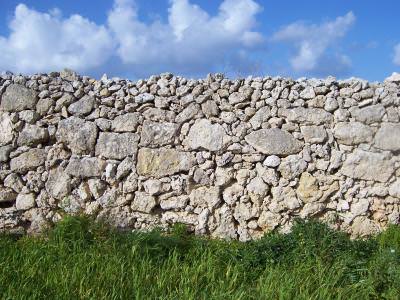Rubble masonry
Rubble masonry, also known as rubblework, is the use of undressed, rough stone, generally for the construction of walls.
The most basic form of rubble masonry is dry-stone rubble walls which are very common in rural locations and popular with landscapers looking for a traditional aesthetic. The rough, unhewn stones are piled on top of one another without mortar, and are often laid in irregular horizontal courses.
Alternatively, the stones can be bound with cement or lime mortar, although in this case, a greater degree of stone selection may be required to avoid excessively wide mortar joints. Stones can be bonded by laying longer ones both along the face and oriented lengthwise across the depth of the wall. Selected stones are laid to form roughly square angles at quoins and around openings.
Polygonal rubble walling is where stones are split-faced and roughly dressed to suit a specific pattern or design. Random rubble walls involve stones of varying sizes and joint widths with small wedge-shaped fillets bedded into the mortar between them.
Rubble masonry can also be used as the outer surface of a wall, particularly common in medieval cathedrals and historic buildings, and as a core infill between external and internal wall faces.
[edit] Related articles on Designing Buildings Wiki
Featured articles and news
Gregor Harvie argues that AI is state-sanctioned theft of IP.
Preserving, waterproofing and decorating buildings.
Many resources for visitors aswell as new features for members.
Using technology to empower communities
The Community data platform; capturing the DNA of a place and fostering participation, for better design.
Heat pump and wind turbine sound calculations for PDRs
MCS publish updated sound calculation standards for permitted development installations.
Homes England creates largest housing-led site in the North
Successful, 34 hectare land acquisition with the residential allocation now completed.
Scottish apprenticeship training proposals
General support although better accountability and transparency is sought.
The history of building regulations
A story of belated action in response to crisis.
Moisture, fire safety and emerging trends in living walls
How wet is your wall?
Current policy explained and newly published consultation by the UK and Welsh Governments.
British architecture 1919–39. Book review.
Conservation of listed prefabs in Moseley.
Energy industry calls for urgent reform.
Heritage staff wellbeing at work survey.
A five minute introduction.
50th Golden anniversary ECA Edmundson apprentice award
Showcasing the very best electrotechnical and engineering services for half a century.
Welsh government consults on HRBs and reg changes
Seeking feedback on a new regulatory regime and a broad range of issues.
























